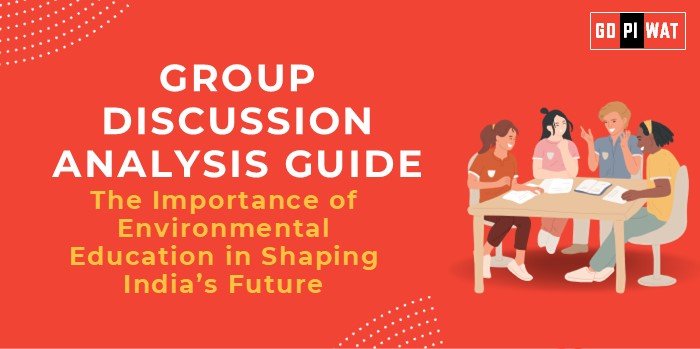📋 Group Discussion (GD) Analysis Guide: The Importance of Environmental Education in Shaping India’s Future
🌐 Introduction to the Topic
Opening Context: Environmental education (EE) has emerged as a critical tool in shaping sustainable behaviors and policies in rapidly developing nations like India. Given the rising environmental challenges, from air pollution to water scarcity, embedding EE into India’s education framework is pivotal for sustainable progress.
Topic Background: The roots of environmental education trace back to global movements like the 1972 Stockholm Conference, which emphasized education for sustainability. In India, the National Policy on Education (1986) recognized the role of EE in fostering awareness. Recent efforts, such as the integration of climate literacy in school curriculums under the NEP 2020, highlight its evolving significance.
📊 Quick Facts and Key Statistics
- 📘 Environmental Literacy Rate: Only 17% of Indian adults demonstrate basic environmental literacy, reflecting a critical need for EE in schools and communities.
- 🌍 Carbon Emissions (2023): India ranks as the third-largest global emitter, contributing to 7% of total emissions, underscoring the urgency for climate education.
- 🌲 Deforestation Rate: Over 30,000 hectares of forest lost annually, highlighting the need for educational initiatives around conservation.
- 💧 Water Scarcity: 54% of India faces high water stress, a vital issue that EE can address through community-level action.
🤝 Stakeholders and Their Roles
- 🏛️ Government Bodies: NEP 2020 advocates for climate literacy in school curriculums. Ministries like the MoEFCC drive awareness campaigns and green skill programs.
- 🏫 Educational Institutions: Schools and universities act as the primary disseminators of environmental knowledge and practical skills.
- 🌱 NGOs and Activists: Organizations like CSE and TERI promote grassroots environmental education and awareness campaigns.
- 🏢 Corporate Sector: CSR initiatives fund projects aimed at environmental awareness and skill-building.
- 🌐 International Bodies: UNEP and UNESCO facilitate EE programs and global resource-sharing frameworks.
🏆 Achievements and Challenges
✨ Achievements
- 📘 Policy Integration: NEP 2020 mandates environmental awareness across all levels of education.
- 🌍 Community Programs: The Green India Challenge has mobilized millions in tree-planting drives.
- 🏫 Eco-Clubs: More than 100,000 schools participate in National Green Corps activities.
- 👩🎓 Youth Engagement: Initiatives like Fridays for Future have galvanized youth into climate action.
⚠️ Challenges
- 📕 Limited Curriculum Integration: EE is often relegated to optional or co-curricular activities.
- 👨🏫 Teacher Training Gaps: Only 23% of teachers feel equipped to teach environmental topics effectively.
- 🏙️ Urban-Rural Divide: EE outreach programs are skewed towards urban schools.
🌍 Global Comparisons
- 🇫🇮 Finland: Environmental studies are a compulsory subject, fostering early awareness.
- 🇧🇹 Bhutan: Gross National Happiness framework emphasizes sustainable education.
📚 Case Study
Kerala’s Environment Literacy Project: This initiative integrates local biodiversity topics into the curriculum, boosting awareness and community engagement.
🗣️ Structured Arguments for Discussion
- ✅ Supporting Stance: “Environmental education is a cornerstone for sustainable development, equipping future leaders with critical thinking skills to combat ecological crises.”
- ❌ Opposing Stance: “Without infrastructural and resource support, introducing EE may overburden an already stressed education system.”
- ⚖️ Balanced Perspective: “While EE is crucial, its success hinges on policy support, teacher training, and inclusive outreach.”
💡 Effective Discussion Approaches
- 📊 Opening Approaches:
- 🔢 Data-Driven: “With over 54% of India facing water scarcity, EE is vital to cultivate water-saving practices among youth.”
- 🌍 Global Comparison: “Countries like Finland lead by example in integrating EE, which India can emulate.”
- 🔄 Counter-Argument Handling: Rebut the resource constraint argument by citing CSR-funded school EE programs.
📊 SWOT Analysis
- 💪 Strengths: Policy support under NEP 2020, rising youth climate activism.
- 🤔 Weaknesses: Lack of teacher training, limited rural penetration.
- 🚀 Opportunities: Green skill programs, global collaboration.
- ⚠️ Threats: Resistance from traditional education stakeholders, funding challenges.
🎓 Connecting with B-School Applications
- 🌿 Real-World Applications: Projects on green marketing, ESG in finance, or sustainable operations in business.
- 📝 Sample Interview Questions:
- 💬 “How can EE influence corporate ESG strategies?”
- 💬 “Propose a CSR initiative to promote EE in rural India.”
- 💡 Insights for B-School Students: Use EE as a lens for studying sustainable business models or supply chain practices.


